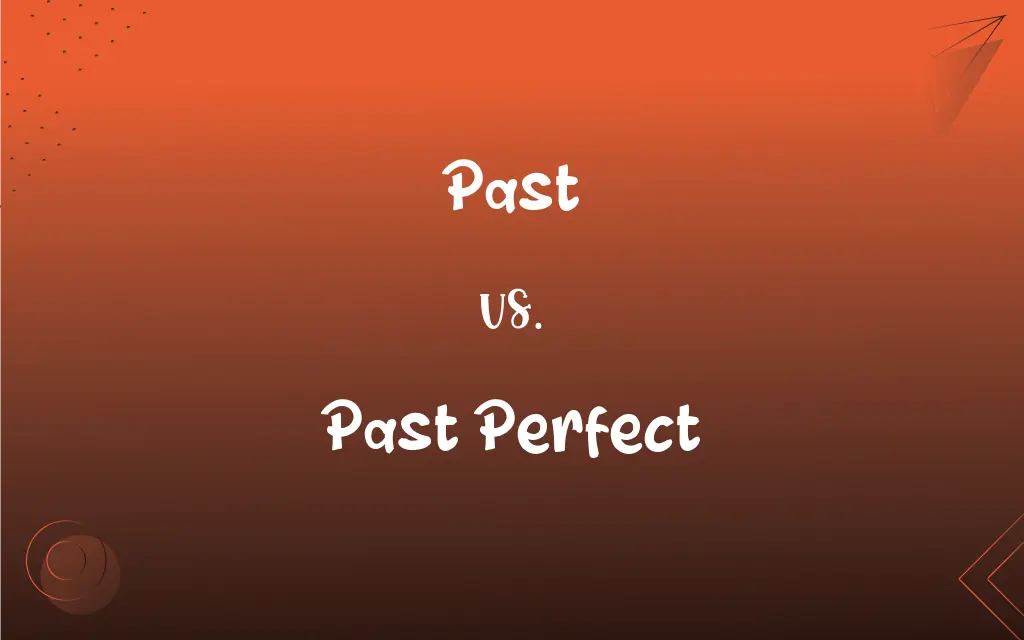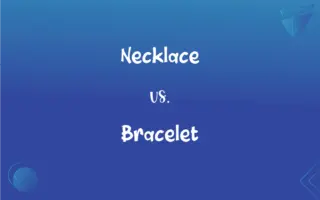Past vs. Past Perfect: What's the Difference?
Edited by Aimie Carlson || By Janet White || Published on December 3, 2023
The past tense describes actions completed in the past, while the past perfect tense indicates an action completed before another past action.

Key Differences
The past tense in English grammar is used to describe actions or events that have occurred at a specific time in the past. In contrast, the past perfect tense is employed to refer to an action that was completed before another action or time in the past.
In the past tense, the focus is on describing a past event or state without necessarily relating it to another time point. Meanwhile, the past perfect tense is used to create a temporal relationship between two past events, highlighting one as having happened before the other.
Regular verbs in the past tense typically end in -ed, such as 'walked' or 'played'. In the past perfect tense, the construction involves 'had' followed by the past participle of the verb, as in 'had walked' or 'had played'.
The past tense is often used for storytelling or describing completed actions, whereas the past perfect tense provides background information, showing causality or sequence in past events.
The past tense is straightforward in its application, while the past perfect tense requires a more nuanced understanding of time relationships in English grammar.
ADVERTISEMENT
Comparison Chart
Focus
Describes completed actions
Indicates an action before another past action
Temporal Relationship
Specific time in the past
Relation between two past events
Typical Form
Verb + -ed (for regular verbs)
'Had' + past participle
Usage
Storytelling, completed actions
Background information, sequence
Grammatical Complexity
Straightforward
Requires understanding of time relationships
ADVERTISEMENT
Past and Past Perfect Definitions
Past
Past tense is used for events that happened previously.
They laughed at the joke.
Past Perfect
Past perfect is used to express the earlier of two past actions.
He had left the party before midnight.
Past
Past tense describes actions completed at a specific time in the past.
She walked to the store yesterday.
Past Perfect
Past perfect sets the background for another event in the past.
They had eaten dinner when we called them.
Past
Past tense narrates actions or events that are no longer happening.
The sun set early last night.
Past Perfect
Past perfect indicates a past action completed before a specific time.
By the time they arrived, the concert had already started.
Past
Past tense expresses a state or situation that existed before now.
He lived in Paris for a year.
Past Perfect
Past perfect tense describes an action completed before another past action.
She had finished her work when he arrived.
Past
Past tense is employed in telling stories about the past.
They played a game last weekend.
Past Perfect
Past perfect shows causality or sequence in past events.
She was tired because she had been studying all night.
Past
No longer current; gone by; over
His youth is past.
Past
Having existed or occurred in an earlier time; bygone
Past events.
In years past.
FAQs
Does past perfect always need a reference point?
Typically, it requires another past event as a reference.
How is the past perfect tense used?
It indicates an action that was completed before another past action.
What is the past tense?
It describes actions or events that occurred at a specific past time.
Can past tense describe a habitual action in the past?
Yes, it can describe regular or habitual actions in the past.
What does past perfect show in a narrative?
It shows the sequence or causality between two past events.
Can past tense stand alone in a sentence?
Yes, past tense can be used independently in a sentence.
What are examples of regular verbs in the past tense?
Words like 'walked' and 'played' are regular verbs in past tense.
How is the past perfect tense formed?
It's formed with 'had' plus the past participle of a verb.
Is past tense used for storytelling?
Yes, it's commonly used to narrate past events in stories.
Why is the past perfect tense important in English?
It's important for accurately depicting time relationships in narratives.
Are time expressions necessary with past perfect?
Time expressions can clarify the sequence but aren't always necessary.
How does context affect the use of past tense?
Context helps determine when to use past tense to describe events.
Are irregular verbs used differently in the past tense?
Yes, irregular verbs have unique past forms, like 'saw' or 'went'.
Can the past tense describe a completed action?
Yes, it's often used to describe actions that are fully completed.
Can past tense be used in conditional sentences?
Yes, it's used in the second conditional for hypothetical situations.
Does past perfect tense need a subsequent past tense clause?
Often, but not always; context determines its necessity.
What's an example of a past participle used in past perfect?
Words like 'done,' 'seen,' and 'written' are past participles.
Does the past tense have different forms?
Yes, including simple past and past continuous forms.
Is past perfect necessary for all past narratives?
Not always, but it adds depth by showing the order of past events.
Is the past perfect tense complex to use?
It requires a good understanding of temporal relationships in English.
About Author
Written by
Janet WhiteJanet White has been an esteemed writer and blogger for Difference Wiki. Holding a Master's degree in Science and Medical Journalism from the prestigious Boston University, she has consistently demonstrated her expertise and passion for her field. When she's not immersed in her work, Janet relishes her time exercising, delving into a good book, and cherishing moments with friends and family.
Edited by
Aimie CarlsonAimie Carlson, holding a master's degree in English literature, is a fervent English language enthusiast. She lends her writing talents to Difference Wiki, a prominent website that specializes in comparisons, offering readers insightful analyses that both captivate and inform.







































































